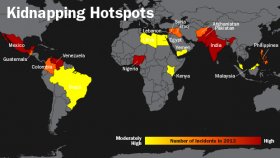
Pinoy Funny

- Share
- Tweet
- Send
- Link
There are lots of reasons people avoid high-profile travel destinations—the flights are too long, the hotels are overpriced, the beaches are overrun with German men in skimpy swimwear. But there’s another, sometimes overlooked criteria that you probably won’t find in your copy of Frommer’s or the Rough Guide: The likelihood of getting kidnapped at gunpoint.
Unless you’re the kind of person who heads to the swamps of Nigeria for a little R&R, it’s unlikely you’ve given much thought to the threat of kidnapping when planning your trips. But kidnapping has boomed over the past decade, thanks to the growing socioeconomic divide around the globe and the spread of radical groups. While kidnappers used to target rich locals, and the abductions were largely confined to a handful of countries, these days foreign business executives and tourists are now just as likely to be the victims, and the abductions can happen virtually anywhere. Public policy groups estimate there were more than 100, 000 kidnappings around the world last year, including locals and foreigners.
While kidnappers used to target rich locals, and the abductions were largely confined to a handful of countries, these days foreign business executives and tourists are now just as likely to be the victims, and the abductions can happen virtually anywhere. Public policy groups estimate there were more than 100, 000 kidnappings around the world last year, including locals and foreigners.
What's My Motivation?
An overwhelming majority of kidnappings today are motivated by aims that are chiefly financial in nature. Although kidnappers’ motivations can (and do) range from ideological to the more amorous and/or custodial (think Helen of Troy), kidnapping has emerged as a lucrative, reliable stream of income for organizations and individuals (consider the fact that ransom payments in 2012 topped $500 million).
To make sense of today’s kidnapping risk overseas, we’ve mapped out the places where you face the greatest danger of getting scooped up by rebels, terrorists or even garden-variety bank robbers. This isn’t simply a list of places with the highest kidnapping rates. That directory would include no-brainers like Syria (which has been fighting a bloody civil war for three years) and Afghanistan (which has become a haven for jihadists). We’re assuming you don’t need someone to tell you that those places are somewhat perilous for travelers.
This isn’t simply a list of places with the highest kidnapping rates. That directory would include no-brainers like Syria (which has been fighting a bloody civil war for three years) and Afghanistan (which has become a haven for jihadists). We’re assuming you don’t need someone to tell you that those places are somewhat perilous for travelers.
Our list focuses, instead, on countries that are first and foremost popular travel destinations—and that also happen to have a high rate of abductions. There are some surprises on the list: India, for example, might seem out of place among the world’s kidnapping capitals, but the numbers don’t lie.

It’s not easy to wrangle data on kidnappings. For one, both governments and kidnapping victims are known to underreport abductions. Also, there are a number of different varieties of kidnapping, and not all countries classify each and every kind as a “kidnapping.” For example, in parts of Asia and Latin America, so-called virtual kidnappings are common—that’s where the bad guys claim falsely that they have abducted someone and demand a ransom. In some countries, these go in the books as “fraud” not “kidnapping.” Another example: “Express kidnappings, ” where hostages are taken for a day or two at most, just long enough to deplete their bank accounts or max out their credit cards, are sometimes are logged as “robberies.”
In pulling together this list, we’ve adjusted for these various quirks and discrepancies to focus on the types of abductions that most often affect tourists and travelers. (See note to the right for more detail on how we came up with the numbers.) The countries below are ordered from most kidnapping incidents to least.




RELATED VIDEO



Share this Post
Related posts
Where to Go in Cebu Philippines?
Cebu, Philippines is the 2009 fourth best island destination in Asia based on Condé Nast Traveler Magazine. A consistent…
Read MoreManila tourist Guide
Manila is chaotic, polluted and thrilling; an old city but one overflowing with life, which is steadily increasing in popularity…
Read More










